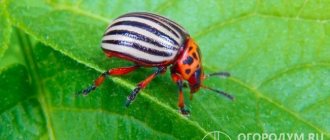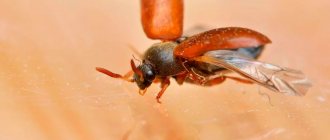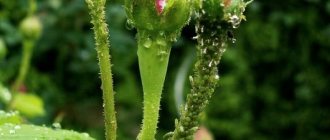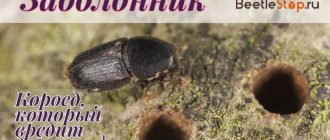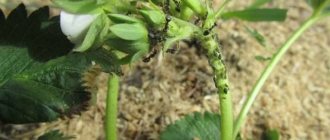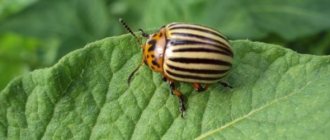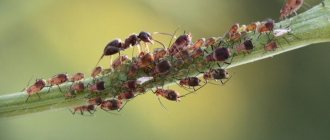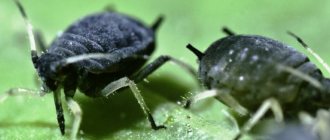What is the danger of the Colorado potato beetle on tomatoes?
When the Colorado potato beetle appears on tomatoes, it does a lot of damage.
The danger of such an invasion lies in the following factors:
- favorable conditions contribute to the activation of the insect and its reproduction;
- the appearance of larvae leads to the rapid consumption of greenery;
- the pest successfully adapts to different climatic conditions;
- The beetle is tenacious and voracious.
The parasite is extremely quickly able to adapt to insecticides, developing resistance to these substances, so it is difficult to get rid of the Colorado potato beetle reliably only using folk remedies or other methods. Dealing with him is quite problematic.
Garlic and onion broth
A product based on onions and garlic has also proven itself to be effective against the voracious pest on tomatoes. It can be used both during the period when Colorado beetles lay eggs and when larvae appear.
Preparation:
- Pour dry onion peels ( 200 g 10 l ), add crushed cloves of garlic to the liquid (take about 2 large heads ).
- Place the container on the stove, cook over low heat at a minimum boil for about two hours, it is advisable not to remove the lid.
- Half an hour before the end of cooking, you can add crushed shag leaves ( 200 g ) to the mixture.
- Leave the broth to brew until completely cooled, strain.
- To ensure that the decoction stays securely on the tomato leaves, you can add liquid soap or laundry soap previously dissolved in hot water to the warm solution.
Spray the tomatoes generously; be sure to also treat the underside of the leaves, where pest larvae most often hide. Treatment, as when using mustard, should be carried out regularly - at least once a week. Can be used during fruiting.
Basic methods of struggle
To get rid of the pest, you can use different methods to protect tomatoes. The main ones include:
- manual collection of individuals;
- agrotechnical control (digging, loosening the soil, changing the planting area);
- chemical preparations;
- influence by folk methods.
20 effective ways to combat the Colorado potato beetle
Manual collection and destruction
You can effectively protect young seedlings and adult tomato bushes by manually collecting the pest. The bright coloring of insects makes them visible on the plant, so it is not difficult to destroy them. If a clutch of eggs is discovered, it must also be removed.
Folk remedies
Treatment of tomatoes, which saves you from the Colorado potato beetle using folk remedies, can be effective if you choose the right means and recipe. The arsenal of these methods is extensive; they can be used to protect crop plantings. Let's take a closer look at recipes from the people.
Onion peel
In the spring, before planting tomatoes in the ground, it is recommended to fertilize the ground with onion peels - this substance is not tolerated by the pest. In the midst of insect activity, it is convenient to use a decoction of onion peels:
- 0.5 buckets of raw materials are poured with hot water;
- the mass is infused for 24 hours, then filtered;
- dilute the liquid with water in a ratio of 1:2;
- Afterwards you need to spray the plant with the composition.
Chicken droppings
Take 40 g of chicken manure per bucket of water, stir and water the plantings. For one bed you need to use 10 buckets of this composition.
Urea
Having noticed that the Colorado potato beetle has begun to eat tomatoes, use a solution of 100 g of urea per bucket of water. Young seedlings should be watered with this liquid. The insect will die, and the plants will be enriched with nitrogen. It is recommended to carry out the event before flowering.
Horsetail and dandelion
Based on these plants, a poison for the pest is prepared. You need to pour boiling water over the herbs and leave for about 20 minutes. Then strain, cool and sprinkle this mixture on the bushes.
Laundry soap and red pepper
You can poison the Colorado potato beetle with a mixture of a piece of laundry soap and ground red pepper (100 g). Combine the ingredients thoroughly in a bucket of water and use to process tomato tops.
Repellent plants
You can save your tomato plantation by using plants that emit an unpleasant odor or confuse insects. Such herbs can be divided into 2 types:
- aromatic plants that disorient pests;
- deterrent plantings (repellents).
Attention! Repelling herbs include calendula, horseradish, nasturtium, garlic, and beans.
Calendula
You can protect the nightshade crop by planting this plant in rows with tomatoes.
Horseradish
It is advisable to plant tomatoes in the area where horseradish grows. The beetle does not like the smell of this plant.
Nasturtium
It is possible to protect yourself from the pest when gardeners use combined plantings. The proximity of nasturtium, which is an excellent repellent against many pests, will be beautiful and useful.
Garlic
Many recipes against parasites use garlic. This crop can also be planted next to tomatoes. The solution is also used against beetles. Tomatoes should be sprayed against the Colorado potato beetle with a mixture of 200 g of garlic pulp along with arrows, diluted in 10 liters of water. The mass is left for a day to ferment, then to improve adhesion, 40 g of soap is added and the plantings are sprayed.
Beans
Many gardeners plant beans around the perimeter of their tomato beds.
Wood ash
This product is unique. It is used for feeding and pest control using various technologies:
- when planting seedlings, pour them into the holes;
- During flowering, dry pollination of the crop is carried out (consumption of 1 kg per 10 sq. m of territory).
It is recommended to carry out activities when there is dew or rain. Up to four such events will be needed per season.
Copper sulfate
A product made from 0.1 kg of the main component and 10 liters of water will help you cope with pests.
Wormwood and ash
It is necessary to prepare a mixture from these ingredients that is lethal to the beetle. To do this, you need to take the components equally (200 g of each), then pour them with slightly heated water and leave to infuse. After letting it sit for several hours, strain the solution and spray the tomato bushes with it.
Tobacco solution
To obtain a mixture for processing, you need to dilute 0.5 kg of tobacco in a bucket of water and let it sit for 24 hours. Then spray with the solution. The frequency of the event is once every 2 weeks.
Herbal infusions
Infusions of various herbs and other vegetation help protect tomato beds.
Celandine
Pour boiling water over 3 kg of raw materials, let stand for 1.5 hours, add 1.5% calcium chloride solution.
Sunflower
The recipe requires 1 kg of plant flowers and 10 liters of water. Mix everything, leave for 72 hours, then spray the beds with liquid.
Poplar
Pour 0.5 buckets of tree leaves with cooled boiling water, put on fire, and boil. Bring the composition to 10 liters and leave for 3 days.
White acacia
Leave 1 kg of dry bark (crushed) in a bucket of water for 72 hours, strain, and spray.
Walnut
Pour 1 kg of fresh leaves into 10 liters of water, leave for a week to infuse, then use as intended.
Special means
Today in gardening stores you can see various chemical preparations that cope quite effectively with the pest when it begins to attack plants. When using them, you must follow safety precautions to avoid poisoning yourself. All such substances act on Colorado potato beetles in different ways, allowing them to protect plants from adult beetles or hatched larvae.
Bankol
This toxic substance, entering the digestive system of the insect, causes immobilization and further death within 72 hours after spraying. Working solution: 5 g of the drug per 10 liters of water, which is enough to treat 0.5–1 hundred square meters of garden.
Bombardier
It is possible to successfully kill pests with the help of this insecticide, which is presented as a powder. It should be diluted as follows: 1 g per bucket of water, which is enough to process 2 acres.
Commander
This drug belongs to the substances of contact-intestinal action. It is used to kill adult beetles and larvae. Applicable in two ways:
- spraying tomato bushes;
- application to the soil.
Read more about how to properly use Komandor against the Colorado potato beetle in the article here.
For 1 hundred square meters of planting, the consumption is as follows: 1 ml of substance per 5–10 liters of liquid.
Karate
The drug affects insects through the nervous system. For spraying, use a solution prepared from 1 ml of the substance diluted in 10 liters of water. The death of pests occurs 30 minutes after treatment. Sometimes Colorado potato beetles die within 3–4 hours.
Killer
This remedy is effective against the beetle at any stage of its development. Its peculiarity is that the insect does not become accustomed to the drug.
Aktara
Spraying with the drug must be carried out during the growing season of tomatoes. To prepare the solution, you need to dilute the product package in a bucket of water. Spraying liquid consumption is 2–4 liters per hundred square meters of plantings.
Gulliver
The growth stimulator is used in conjunction with the systemic insecticide “Zhuk”. Dissolve the “Bug” product completely in clean water, stirring thoroughly. Then “Gulliver Stimul” is additionally added to the composition. The finished solution must be homogeneous in composition. The product must be used immediately after preparation, since it cannot be stored.
Bison
To treat 1 hundred square meters of tomato plantings, 1 ml of the drug is enough. After diluting the substance according to the instructions, you need to spray the bushes on which the beetle appeared.
Inta-Vir
The poison is sold in the form of a tablet, which must be dissolved in 10 liters of water. Treatment of bushes must be done in the morning or evening, in dry weather. One tablet is enough to kill beetles on 1 acre of plantings.
Calypso
A systemic insecticide protects against beetles at any stage of its development. To prepare the solution, you need to dilute 1 ampoule in a glass of water, then add the volume of the finished liquid to a volume of 10 liters. This amount of the drug is enough to spray 1 acre of plantings.
Fas
The drug tablet should be diluted in 5 liters of water. The resulting solution is enough to process tomatoes on 1 acre.
Karbofos
An insecticide that has earned popular recognition. The ampoule with the product must be dissolved in 5 liters of water. Spray the plants with the resulting liquid.
Prestige
To obtain a poisonous liquid, dilute 10 ml of the purchased concentrate in a liter of water. Before planting it in open ground, the roots of the seedlings must be soaked in the resulting solution for 8 hours. After this, land.
Prestige remedy for the Colorado potato beetle - instructions for use
Mustard solution
This product is completely safe for tomatoes. It also won’t do much harm to Colorado beetles, but it will keep pests away from tomato beds for a long time.
Preparation:
- dry mustard ( 100 g ) in warm water ( 10 l ).
- Add table vinegar ( 100 ml ).
- a piece of soap (about 50-60 g ), beat until the soap grains dissolve in a small amount of hot water.
- Pour the soapy liquid into the main solution and mix well.
Spray the tomatoes generously with the resulting solution . It is better to do this in the evening, after sunset. If you carry out the treatment during the day, a burn may appear on the leaves of the tomatoes. Excellent for use during fruiting of tomatoes.
The disadvantage of mustard is that it does not last long; in order to reliably protect tomatoes from the pest, spraying is recommended every week.
Prevention measures
In order to prevent insect invasion, it is recommended to plant tansy, cilantro, sage, mint, coriander, basil, and calendula between the rows of tomatoes. When planting young plants in the ground, it is advisable to pour 1 tbsp. l. ash.
Interesting! The bed needs to be mulched with pine sawdust. Their pungent smell will repel insects. It is important to follow a work schedule here. Spread the sawdust for the first time before flowering begins - once every 2 weeks. After this, scatter the pine needles once every 30 days.
It is also necessary to carry out regular hilling, which contributes to the saturation of the soil with oxygen and the death of young larvae. The following will help reduce the appearance of insects:
- crop rotation;
- planting crops in a greenhouse;
- strengthening the immunity of tomatoes with Epin and Silk;
- filling the soil with organic matter (over 15 cm);
- planting varieties that are “unpalatable” to the pest.
Types of Tomato Pests
Tomatoes are damaged by both pathogenic microorganisms and parasitic insects, which belong to different species and have various negative effects on plants. Based on this, it is very difficult to classify all existing pests into separate groups.
Entomologists conditionally divide tomato pests into 2 groups. The first group includes insects that damage the root system, and representatives of the second group infect the above-ground parts of plants - flowers, leaves and fruits. To detect a problem in a timely manner, it is important to know how a particular parasite manifests itself, and what needs to be done to prevent its occurrence or quickly eliminate it.
Additional tips and tricks
It is advisable in the spring to cover the soil around the planted seedlings with non-woven material. Mulching the soil around the plantings also has a good effect.
It also helps to prevent the Colorado potato beetle from reaching the plants if you dig trenches along the rows of seedlings and place a black film on their bottom. Insects weakened by a long winter will roll onto such traps themselves, after which all that remains is to collect them there.
Advice! Wanting to protect tomatoes as much as possible from the invasion of the Colorado potato beetle, never plant young seedlings in close proximity to potato beds.
To summarize the above, it should be noted that gardeners have come up with quite effective, but harmless to humans, methods of getting rid of the Colorado potato beetle. It is advisable not to use strong chemicals unless absolutely necessary. Only in this situation will it be possible to obtain a truly useful, environmentally friendly harvest of tomatoes on your own country plot, which can be safely harvested as canned food for the winter.
Damage from insects
They cause the greatest damage to fields, namely grain crops, which is significantly reflected in the harvest. The fact is that at any stage of growth they need food, first young shoots and then grain. And if you take into account the stage of reproduction, then you can remember the larvae, which also want to eat.
They cannot eat grain in its pure form, for example, like rodents. It looks like this: an adult bites into a grain, after which a special enzyme is released that can completely change the structure of the grain. Next, the middle of the grain changes, and the structure becomes liquid. It is in liquid form that the insect eats it.
This procedure for absorbing food is also dangerous (for the crop) because it is enough for it to simply release its enzyme and the grain deteriorates and becomes unusable. In order to somehow protect the harvest, plants are checked at absolutely all stages of growth, from shoots to the harvest period. Of course, in order to not give the bugs a chance and to protect your future harvest, you will need to process them and do this procedure effectively during the period of milk maturity.
Non-infectious (physiological) diseases
Apical rot
A physiological disease of tomatoes caused by a lack of calcium and water.
| Causes | The disease appears due to inadequate care and poor growing conditions. Main reasons:
|
| Symptoms | Dark brown or dark spots appear on the tops of the fruit, which over time can expand and cover a larger area of the tomato. The spots sink in, the flesh underneath is hard and dry. |
| Risk factors | Tomato diseases often occur during drought or high soil and air temperatures. This is rarely caused by a physical lack of calcium in the soil, but occurs mainly due to disturbances in the absorption and transport of this element in the plant. |
| Prevention | Large fluctuations in temperature, salinity, dry or excessively flooded soil, too low a pH and the accumulation of potassium and nitrogen ions are just some of the factors that interfere with the absorption of calcium. In such situations, the only effective and fast way to deliver calcium is the use of fertilizers in the form of foliar feeding (spraying leaves). |
| Measures to protect against illness | During the period of fruit formation and setting, it is recommended to spray with calcium fertilizers. One of the proposed solutions is liquid fertilizer EKOLIST Calcium - a chlorine-free concentrate of calcium fertilizer with nitrogen, magnesium and a set of microelements, which, in addition to replenishing calcium deficiency, improves plant metabolism, providing them with all the necessary microelements. |
Fruit cracking
| Causes | Cracking of tomato fruits is caused by:
|
| Prevention | Recommended:
|
Falling of flowers and ovaries
| Causes |
|
| Prevention | When transplanting seedlings with the addition of nitrogen fertilizers into the hole, poor fruit set can be caused. |
Uneven coloring of fruits
Disturbances in the growth and development of tomato plants often lead to uneven coloring of the fruit. Regardless of unusual atmospheric and agrotechnical conditions, color disturbances can also be the result of various infectious diseases.
| Causes |
|
| Prevention | Proper fertilization, shading |
Effect of high temperature - burns
When the weather changes suddenly, there is a sudden temperature change. When heat sets in, the temperature at noon exceeds 30 °C, and in greenhouses with insufficient ventilation and shading it is 15 °C higher than outside. Under such conditions, almost all metabolic processes at the level of plant cells and tissues are disrupted. Substances necessary for growth do not reach the fruit in sufficient quantities.
The fruit does not color evenly because lycopene, which gives tomato fruit its red color, is not produced when temperatures exceed 32°C for several hours a day. Such a high temperature does not interfere with the formation of carotene and brick spots appear on the fruits. These symptoms usually occur when the fruit is near glass slides and not covered by leaves. Sometimes white spots may appear if the tissues of sun-heated fruits die due to exposure to too high a temperature.
Photo. Sunburn sometimes resembles the symptoms of dry rot in tomatoes, caused by a lack of calcium or water, with the difference that in dry rot the necrosis is brown and sometimes black. Darkening of part of the fruit occurs as a result of sunburn; the lack of lycopene synthesis causes the yellow color of the fruit.
Potassium deficiency
Uneven coloring is caused by potassium deficiency, the deficiency of which leads to inhibition of lycopene synthesis and a delay in the breakdown of chlorophyll in ripening fruits.
The following symptoms - green and yellow spots (pictured below) - increase with excess nitrogen and often occur at the base of the fruit.
Photo. Orange heel, caused by potassium deficiency, is sometimes accompanied by arched cracks resulting from the heel maturing later than the rest of the fruit.
Tomato fruits have an increased need for potassium - one plant consumes up to 25 g of this element during the growing season. The demand for potassium is greater in autumn when there is a lack of light (in November) than in summer. The potassium content in the leaves should be 4.5-7% of dry matter, and in December and November it can reach 8%. Too much potassium application to prevent uneven coloring of fruits sometimes reduces the yield by 10%.
Potassium deficiency is indicated by yellowing and browning of the edges of leaves, growth of clusters at an acute angle, which causes them to peel off and break off under the weight of the fruit. Tomatoes with potassium deficiency are less tasty due to the reduced content of sugars, acids, and dry substances.
The physiological abnormalities in fruit coloration described above may be confused with the effects of certain pathogens. Internal darkening can be caused by bacteria from the genus Erwinia, Bacillus and Aerobacter. Similar symptoms can also be caused by the mosaic virus.
Golden dots are a sign of excess calcium
Microscopic examination showed that in the place where golden dots appear - orange, glowing spots on tomato fruits - under the skin there are pulp cells filled with crystalline forms of calcium. This is a relatively recent problem in tomato production. One of its causes is excessive feeding with calcium or excessive absorption of this ingredient by plants.
Photo. “Golden dots” on tomatoes are a sign of excess calcium.
Stolbur
The main causes of the disease are high air and soil temperatures. To prevent disease, tomatoes should be shaded during the hottest hours of the day, choosing appropriate planting sites. Mulching moistened row spacing has a positive effect.
Where do bugs come from?
Beetles, with the help of their well-developed, strong wings, can cover long distances. They prefer to feast on the leaves, buds and flowers of fruit trees. But not every garden falls under their attention. Adult individuals, first of all, think about their offspring, and therefore choose predominantly sandy and sandy loam soils for habitat. Fertile, loose areas fertilized with manure - underground passages can easily be built in them. And in the depths of such soils it remains warm even in winter, which means that the larvae can calmly survive the cold period, and in the spring they can get to the surface and attack newly planted vegetable seedlings. In addition, beetles reproduce in nitrogen-depleted soils. Therefore, if you neglected to apply nitrogen-containing fertilizers in the fall, then most likely the cockchafer has already taken a fancy to your garden.
Preventive measures
The main measures to prevent the appearance of bedbug larvae on tomatoes and other plants are cleaning the garden or greenhouse area in the fall . This way, adult pests will not have the opportunity to spend the winter on the site, and they will leave the garden in search of fallen leaves and other shelters.
In open garden beds, all tops and weed residues are collected and burned. If possible, the soil should be dug up: both the larvae of other pests and weed seeds will die. In the greenhouse, plant remains are collected and removed. All surfaces are treated with solutions of Karbofos, bleach, or ignition of sulfur bombs is carried out.
How to detect?
Stages of bedbug development.
The insects are quite large and can be seen on any part of the bush: they crawl on leaves and unripe tomatoes.
Varieties with a green color are almost invisible if they are motionless, and they can be found when picking tomatoes or caring for plants by accidentally disturbing the insect: it secretes a liquid with a strong unpleasant odor.
Black-and-white and brownish larvae do not blend into the background so well and attract the attention of the gardener.

